Introduction
Biodiversity maintains not only the ecological balance but also provides food resources including local fisheries which are essential bestowing economic opportunities, and underpin the sustenance and well-being of the local population. The North Western Himalayas are characterized by an extensive glacial system and serve as a significant source of fresh water. The freshwater bodies of this region exhibit high levels of biodiversity including ichthyofauna and shellfishes. Himalayapotamon emphyseteum and Maydelliathelphusa masoniana are freshwater culture crab species distributed geographically in the Indus and Ravi river systems flowing through the Jammu region. These crabs act as essential stewards of freshwater ecosystems, actively shaping the environment. Through nutrient cycling, maintenance of habitats, food web contributions, and support for ecosystem diversity, they play a critical role in maintaining the health, balance, and resilience of these habitats. It is not only an excellent source of protein but also essential fatty acids and possesses clinical significance.1
Minerals are widely acknowledged as vital components necessary for supporting and maintaining various physiological functions crucial to human health, playing a fundamental role in ensuring the proper functioning of bodily systems and contributing to overall well-being. Minerals are taken directly by fishes and shellfish through gills and body surfaces directly from the water body.2 Minerals play a significant role as essential components of hormones, enzymes, and activators of enzymes in human nutrition.3 The human body is unable to produce minerals internally; therefore, we need to acquire them from food, supplements, or other external sources.4,5 Aquatic organisms absorb minerals from the food they intake and the surrounding water, which then accumulate in their muscle, skeletal tissue, and various organs.6 Crabs being benthic invertebrates, have close contact with sediments and accumulate minerals by food and adsorption.7-9 Minerals play a role in many biological processes by being integral components of numerous enzymes. Minerals are important for organisms as they play a pivotal role in the formation of skeletal structures, the regulation of the colloidal systems, and acid-base balance.10
The shells and muscles of crabs both are good sources of minerals. The shell minerals provide more calcium (Ca), iron (Fe), and magnesium (Mg) than the meat. The shell of the crab is utilized by the feed mill industries as a source of minerals for animal feed. Also, it serves as a source of chitin and chitosan, which are utilized in the health industry for their anti-bacterial, immunological, anti-cancerous, and anticoagulant properties.11 Crabs being smaller in size can be utilized as an additive in fish products for animal feed production. The Harris mud crab, Rhithropanopeus harrisii being smaller in size is a valuable source of micronutrients. Both the shells as well as the meat of crabs provide beneficial minerals to humans. The shell is rich in calcium (Ca), magnesium (Mg), and iron (Fe), whereas the meat is a rich source of sodium (Na) and potassium (K).12 Crabs are rich sources of minerals like calcium, potassium, phosphorus, magnesium, zinc, copper, manganese, and iron.13,14
Calcium is essential for various physiological functions, including clotting of blood coagulation, muscle contraction, the transmission of nerve impulses, and several metabolic processes.15 It is also important in developmental stages for the growth of bones and muscles, as well as for the prevention of rickets and soft bone disease. Magnesium maintains the osmotic balance of extracellular fluid and blood plasma.16 Potassium is the main intracellular cation required for maintaining acid-base balance, blood pressure, and muscle contraction.17 Phosphorus is a crucial mineral for maintaining hydrogen ion concentration nucleotide synthesis, cell communication, and storing and transferring of energy.18 Sodium is an important cation that has key roles in the regulation of fluid balance and muscle contraction. The abnormal levels of sodium may cause cell damage and renal problems which may be fatal for human health.19 Zinc is a trace element that has benefits in many physiological functions like immune function, cell growth and repair, synthesis of hormones, wound healing, and reproduction. Deficiency of zinc may lead to many health problems including low growth and poor reproductive performance.20
Copper acts as a cofactor for many enzymes required for the regulation of biochemical reactions taking place in the body.21 Among the various micronutrients, iron, zinc, and selenium act as the first line of defense, as these micronutrients are required by the body’s physical barriers, i.e. the skin and respiratory lining for integrity.22 Selenium (Se) is an essential micronutrient. It is a key component of various selenoproteins which have a pivotal role in antioxidant systems (e.g., glutathione peroxidase) that protect against damage from reactive oxygen species and free radicals, thus adding anti-cancerous properties to food.23 It has been indicated from various studies that selenium can mitigate the harmful effects of mercury, especially organic methylmercury.24 Manganese acts as a key component of many enzymes and activates metal-enzyme complexes.25 It is required for the human diet, but if present in excess can result in Parkinsonian pathology.26 Knowing the mineral composition of important aquatic foods is important for establishing the connection between the production of food, and its accessibility and for framing policies and developmental programs that improve production. This knowledge ensures that the food supply effectively meets the nutritional requirements of people. Several studies have examined the nutritional composition of marine and freshwater species; there is limited research on the mineral profile of freshwater crabs from the Himalayan region, particularly Himalayapotamon emphyseteum and Maydelliathelphusa masoniana. Existing research on the nutritional profile of crabs in the Jammu region is limited. So, the primary aim of this research is to evaluate freshwater crabs of the Jammu region for their mineral composition and assess the contribution each mineral provides through the consumption of these crabs. Evaluating the mineral composition of these crabs will not only expand scientific knowledge but also provide insights into their potential as sustainable, nutrient-rich food sources for communities in resource-constrained regions.
Material and Methods
Collection of Crab Samples
Samples of crab Himalayapotamon emphyseteum and Maydelliathelphusa masoniana were collected from the tributaries of the Chenab and Ravi river system, which flows through the Jammu division (Figures 1, 2, and 3).
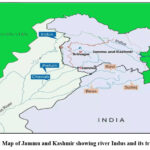 |
Figure 1: Map of Jammu and Kashmir showing river Indus and its tributaries |
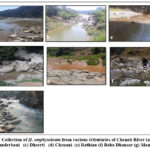 |
Figure 2: Collection of H. emphyseteum from various tributaries of Chenab River (a) Jhajjar (b) Sunderbani (c) Dheerti (d) Chenani (e) Rathian (f) Baba Dhansar (g) Mantalai. |
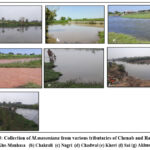 |
Figure 3: Collection of M.masoniana from various tributaries of Chenab and Ravi river (a) Gho-Manhasa (b) Chakrali (c) Nagri (d) Chadwal (e) Kheri (f) Sai (g) Akhnoor |
The two species (Figure 4) were selected due to their availability and consumption by local communities, and collection was done during the post-monsoon season, with adult specimens gathered from a total of fourteen survey sites-seven sites for each species. They were then brought to the Laboratory, Department of Zoology in the ice box with a temperature maintained at -4℃. From each site, seven crabs were randomly selected, with a weight range of 48±1.08grams and 53±1.20grams, respectively. These samples were then prepared for further laboratory processing.
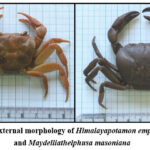 |
Figure 4: External morphology of Himalayapotamon emphyseteum and Maydelliathelphusa masoniana |
Analysis of Mineral Composition
Extracted muscles were initially kept in the oven for drying at 105°C for 6 to 8 hours. Subsequently, 2.5g of each dried sample was transferred into digestion flasks and 25 ml of nitric acid was added. The flasks were kept on a hot plate at 120°C and maintained until the samples were completely digested. 10 ml of 70% HClO4 was added slowly after complete digestion of the sample. The mixture was then gently boiled until it became nearly colorless. The solution was filtered and diluted to a volume of 100ml with deionized water. The estimation of minerals in the samples was determined using Atomic Absorption Spectrophotometry.27 Selenium was analyzed using the inductively coupled plasma mass spectrometry (ICP-MS) method.28 All measurements were conducted in triplicate to ensure consistency and procedural blanks were included to monitor contamination. Calibration was performed using certified reference materials, and all samples were analyzed in triplicate to ensure consistency.
Statistical Analysis
Data evaluation was performed using MS Excel and MATLAB software, with significance determined at a threshold of p < 0.05. Additionally, a mosaic plot was generated using PAST 4.03 software to visually represent the data.
Estimation of Daily Intake of Minerals (DIM)
The daily intake of metals was calculated using the following equation.29

The conversion factor (CF) of 0.085 was used for the conversion of the samples to dry weights. The average per capita consumption of fish and shellfish in India for human food is 8.89 kg and the average body weight for the adult population was 60 kg.30
Results
The current study shows that crab meat is a rich source of minerals that are beneficial for human consumption (Figures 5 and 6). The richness of sodium, magnesium, potassium, and calcium, is a key attribute of any high-quality edible food, 31, 32, and these minerals were found in abundance in the crabs examined during the present study thereby making them inclusive in high-quality edible foods. Different minerals i.e., Calcium(Ca), Iron(Fe), Phosphorus(P), Potassium(K), Manganese(Mn), Zinc(Zn), Sodium(Na), Copper(Cu), and Magnesium(Mg) were found in the crab species. However, the levels of different minerals vary among the studied crab species. The mineral content in H. emphyseteum was found to be in the order Ca > P > K > Na > Mg> Fe > Zn >Mn > Cu and the same was found in M. masoniana except for Cu which is more than Mn. The calcium content in freshwater crabs, H. emphyseteum, and M. masoniana in the current study showed the maximum value among all the minerals and the calcium levels were 4867.958 and 4624.226 mg/100gm respectively.
The sodium content in crabs, H. emphyseteum, and M. masoniana were found to be 222.535mg/100gm and 227.134mg/100gm respectively. The present study on H. emphyseteum and M. masoniana indicates that these crabs are good sources of phosphorous. The crabs, H. emphyseteum, and M. masoniana of the Jammu region are a good source of iron consisting of 33.530mg/100gm and 36.120mg/100gm of iron content, respectively. The present study on H. emphyseteum and M. masoniana reveals higher levels of potassium than Paratelphusa lamellifrons with a potassium content of 256.77 mg/100gm and 275.20 mg/100gm respectively.
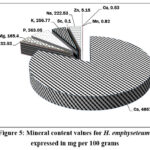 |
Figure 5: Mineral content values for H. emphyseteum, expressed in mg per 100 grams |
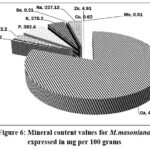 |
Figure 6: Mineral content values for M.masoniana, expressed in mg per 100 grams |
Invertebrates exhibit physiological and biochemical detoxification processes to regulate and accumulate zinc and copper concentrations in their tissues.7 In the present study, the copper content of 0.534mg/100gm and 0.623mg/100gm in H. emphyseteum and M. masoniana was observed respectively. The sodium and zinc content in H. emphyseteum was 222.535 mg/100gm and 5.158mg/100gm whereas the sodium content was slightly higher in M. masoniana (227.134mg/100 gm) and zinc was found to be in lesser amounts (4.916mg/100 gm). Magnesium plays a crucial role in various bodily functions and is much required for oxidative phosphorylation, production of energy, and glycolysis. The content of magnesium in freshwater crabs under current investigation is higher than in marine crabs. Selenium is an effective antioxidant that helps in the removal of oxidative stress. Moreover, selenium is an integral component of glutathione peroxidase and plays a crucial role in preventing cellular damage caused by reactive oxygen species.,44,45,46 The selenium and manganese levels in H. emphyseteum are 0.105mg/100gm and 0.821mg/100gm whereas, in M.masoniana, the levels of selenium and manganese are 0.213 mg/100 gm and 0.517 mg/100 gm respectively. Significant variations (p<0.05) were observed among the different minerals in crabs, H.emphyseteum, and M.masoniana by using one-way ANOVA.
Daily Intake of Minerals
The daily intake of minerals (DIM) from Himalayapotamon emphyseteum was calculated using the formula and the DIM for minerals viz., Ca, Fe, Mg, P, K, Se, Na, Zn, Cu, Mn was found to be 0.61, 0.004, 0.02, 0.045, 0.032, 0.00105, 0.027, 0.006, 0, 0.0001. Similarly from Maydelliathelphusa masoniana, the daily intake value of minerals viz., Ca, Fe, Mg, P, K, Se, Na, Zn, Cu, Mn was obtained as 0.58, 0.45, 0.02, 0.04, 0.03, 0.00002, 0.028, 0.0006, 0.00007, 0.00006 (Figure 7).
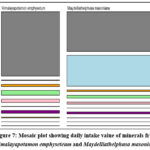 |
Figure 7: Mosaic plot showing daily intake value of minerals from Himalayapotamon emphyseteum and Maydelliathelphusa masoniana |
The mosaic plot graph draws a comparison among the minerals present in Maydelliathelphusa masoniana and Himalayapotamon emphyseteum. A large gray-colored box showing the calcium content in H.emphyseteum is suggestive of the fact that it is a substantial contributor of this specific mineral in comparison to other species. M.masoniana has two large segments (gray, Ca, and blue, Fe), this differentiation indicates that this species delivers a diverse and well-rounded mineral profile. Besides this, the graph for M.masoniana is wider than H.emphyseteum which is due to the reason, that the former species shows a more diverse distribution of minerals, especially in the blue portion (Fe). Although H.emphyseteum exhibits elevated levels of some particular minerals, the cumulative mineral content is higher for M.masoniana, as reflected by the broader graph.
Discussion
The study on the Indian Ocean swimming crab, Charybdis smithii has depicted that sodium content is the highest followed by calcium, potassium, and magnesium.33 When compared to marine crabs such as Charybdis smithii, presently studied freshwater species exhibit lower sodium levels, possibly due to the differences in salinity between habitats. Calcium is predominantly present in the form of calcium carbonate and is the main constituent of the crustacean exoskeleton.34 Besides calcium carbonate, Ca is found in the form of chitin and protein. In P. sanguinolentus, the calcium level was found to be 445.5 ± 0.56 mg/100gm and in P. pelagicus, the calcium content was 111±32.14 mg/100gm.2 The concentration of minerals in crab meat is influenced by various factors, like the season, food sources, sex, and the chemistry of water. The higher calcium content in H. emphyseteum may be attributed to differences in habitat conditions or feeding behavior, as calcium uptake is influenced by both environmental and dietary factors. During the premoult period, the calcium is accumulated in the hepatopancreas which is utilized for exoskeleton calcification.35, 36
The phosphorus content found in the present study is much higher than the content of phosphorus levels in mud crabs, Scylla serrata 46.02mg/100g and 65.54mg/100g, in males and females respectively.37 Iron is considered a crucial trace element for various functions within the human body, such as transporting oxygen from the lungs to tissues and preventing significant health issues. 38, 39, 18 The content of iron as reported in Paratelphusa lamellifrons ranges between 42.3 to 48.7mg/100gm which is higher than the iron levels reported in H. emphyseteum and M. masoniana. The freshwater crabs are modest sources of potassium as studied in Paratelphusa lamellifrons.18 The potassium levels reported in this crab vary between 103.7 mg/100gm to 119.2 mg/100gm with maximum levels in the cephalothorax. The presence of copper and zinc in the muscles of crabs enables them to survive in high concentrations of these metals in environmental conditions.,40, 41Levels of sodium and zinc in freshwater crab, Isolapotamon bauense was found to be in concentrations of 10mg/g and 0.45mg/g respectively.42 Magnesium is known as an enzyme system activator that plays a significant role in the energy production metabolism of carbohydrates.43 The magnesium content is approximately 54.31mg/100gm in the Indian Ocean swimming crab, Charybdis smithii which is much lesser than that found in the crabs under present investigation.32 Besides this, the magnesium levels in our study are higher than studies done on crabs, P. sanguinolentus, and P.pelagicus.2 The daily intake of minerals from a crab, Sudanonautes aubryi was examined11 in which DIM for different minerals Ca, Na, Mg, K, and Fe was reported as 0.017, 0.016, 0.028, 0.41, and 0.011 respectively which is similar to the present study.
Conclusion
Based on the current investigation into the mineral content of crabs found within the Chenab and Ravi river systems in the Jammu region, it is evident that these crabs hold significant potential as a nutritional food source. They are abundant in essential minerals such as calcium, magnesium, phosphorus, and sodium, and also provide moderate amounts of selenium, zinc, and iron. The analysis of the Daily Intake of Minerals (DIM) further suggests that the inclusion of these crabs in the diet can contribute to a balanced and nutritious diet, potentially preventing a range of health-related issues. Furthermore, the regular consumption of these crabs could play a crucial role in alleviating food shortages, offering a sustainable solution to food insecurity over the long term in the region. While these crabs show promise as a nutrient-rich food source, further studies are necessary to assess the risks posed by toxic metal contamination. Extracts from these crabs hold potential for use in natural mineral supplements, offering a sustainable solution for addressing health conditions such as anemia and mineral deficiencies. Their mineral-rich composition not only supports human health but also provides valuable insights into their ecological roles within food webs. These crabs contribute to the bioaccumulation of minerals, highlighting their significance in nutrient cycling and maintenance of ecosystem balance and consumption guidelines to ensure safe human consumption. This study addresses the gap in understanding the mineral content of Himalayan freshwater crabs by providing detailed mineral analysis and assessing their potential to meet daily dietary mineral requirements.
Acknowledgement
Authors are highly obliged to the Head, Department of Zoology, University of Jammu, for providing the necessary laboratory facilities to carry out the research work and to DST-PURSE (Department of Science & Technology, Promotion of University Research and Scientific Excellence), DST-FIST (Department of Science and Technology, Fund for Improvement of S&T Infrastructure), Indian Council of Medical Research, New Delhi (No. NER/62/(9)2018-ECD-1 Dated:31-08-2018) and DBT-BUILDER programme (No. BT/INF/22/SP47656/2022 Dated:30/11/2022) for providing necessary equipment that has been used in the present research work. The authors are thankful to the JK Science, Technology, and Innovation Council, Department of Science and Technology (No. JKST&IC/J/14/2022/100-04 Dated:23-01-2024) for providing the funding necessary for this research.
Funding Sources
The first author is highly thankful to UGC (University Grants Commission) for providing a Junior Research Fellowship (Award No. 221610205283).
Conflict of Interest
The authors declare no conflict of interest, financial or otherwise.
Data Availability Statement
This statement does not apply to this article.
Ethics Statement
This research has been approved by the Institutional Ethics Committee, University of Jammu.
Informed Consent Statement
This study did not involve human participants, and therefore, informed consent was not required.
Permission to Reproduce Material from other Sources
Not applicable
Clinical Trial Registration
Not applicable
Author Contributions
- Mukul Adotra: Sample Collection, Experimental Research, Methodology, Writing – Original Draft.
- Menakshi Dhar: Data Collection, Statistical Analysis, Writing – Review & Editing.
- Seema Langer: Conceptualization, Visualization, Supervision, Writing – Review & Editing.
- Shivam Koul: Computational, Formatting Assistance.
References
- Manhas P. Studies on some nutritional aspects and clinical significance of shellfishes (prawns and crabs) of Jammu region. D. thesis submitted to University of Jammu, Jammu. 2017.
- Rangasamy E., Muthu V.L., Dhanabalan K., Muniyandi M. Determination of proximate composition on some edible crabs with special reference to nutritional aspects collected from coastal waters of Rameshwaram, Tamil Nadu. Food Chemistry Advances. 2024;4:100686. https://doi.org/10.1016/j.focha.2024.10068.
CrossRef - Khan A.H., Ali M., Biswas S.K., Hadi D.A. Trace elements in marine fish from the Bay of Bengal. The Science of Total Environment. 1987;61:121-130. https://doi.org/10.1016/0048-9697(87)90362-7.
CrossRef - Śmietana N., Panicz R., Sobczak M., Nędzarek A., Śmietana P. Variability of elements and nutritional value of spiny-cheek crayfish (Faxonius limosus, Rafinesque, 1817): Variability of elements and nutritional value of limosus. Journal of Food Composition and Analysis. 2020;94:103656. https://doi.org/10.1016/j.jfca.2020.103656.
CrossRef - Nędzarek A., Czerniejewski P. The edible tissues of the major European population of the invasive Chinese mitten crab (Eriocheir sinensis) in the Elbe River, Germany, as a valuable and safe complement in essential elements to the human diet. Journal of Food Composition and Analysis. 2021;96:103713. https://doi.org/10.1016/ j.jfca.2020. 103713.
CrossRef - Lall S.P. The minerals. In: Fish Nutrition. (Halver, J.E., Ed), 2nd edn., Academic Press, New York 1989; 219-257. doi: 3390/ani11092711.
CrossRef - Firat Ö., Gök G., Çoğun H.Y., Yüzereroğlu T.A., Kargin F. Concentrations of Cr, Cd, Cu, Zn and Fe in crab Charybdis longicollis and shrimp Penaeus semisulcatus from the Iskenderun Bay, Turkey. Environmental Monitoring and Assessment.2008;147:117-123. https://doi.org/10.1007/s10661-007-0103-7.
CrossRef - Dange S., Manoj K. Bioaccumulation of heavy metals in sediment, polychaetes (annelid) worms, mud skipper and mud crab at Purna River Estuary, Navsari, Gujarat, India. International Journal of Current Microbiology and Applied Sciences. 2015;4(9):571-575.
- Nędzarek A., Czerniejewski P., Drost A., Harasimiuk F., Machula S., Tórz A., Masalski P. The distribution of elements in the body of invasive Chinese mitten crabs (Eriocheir sinensis Milne-Edwards, 1853) from Lake Dąbie, Poland. Journal of Food Composition and Analysis. 2017;60:1-9. https://doi.org/10.1016/j.jfca.2017.03.003.
CrossRef - Olmedo P., Hernández A.F., Pla A., Femia P., Navas-Acien A., Gil F. Determination of essential elements (copper, manganese, selenium and zinc) in fish and shellfish samples. Risk and nutritional assessment and mercury–selenium balance. Food and Chemical Toxicology. 2013;62:299-307. DOI: 1016/j.fct.2013.08.076.
CrossRef - Ahmed A.A. Mineral and amino profile of crab (Sudanonaonautes aubryi). Food Chemistry Advances. 2022;1:100070. https://dx.doi. org/1016/j.focha.2022.100070.
CrossRef - Jimmy U.P., Arazu V.N. The proximate and mineral composition of two edible crabs Callinectes amnicola and Uca tangeri (Crustecea: Decapoda) of the Cross River, Nigeria. Pakistan Journal of Nutrition. 2012;11(1):78-82. https://doi. org/3923/pjn.2012.78.82.
CrossRef - Skonberg D.I., Perkins B.L. Nutrient composition of green crab (Carcinus maenus) leg meat and claw meat. Food Chemistry. 2002;77:401-404. https://doi.org/10.1016/S0308-8146(01)00364-8.
CrossRef - Kusumawati N. Utilization of shrimp shell waste as raw material for the manufacture of ultrafiltration membranes. Inotek. 2009;13(2):113-120.
- FAO/WHO. Human vitamins and mineral requirements. Report of Joint Food and Agricultural Organizations of the United Nations/World Health Organization Expert Consultation. Bangkok, Thailand. 2002.
- Turan M., Kordali S., Zengin H., Dursun A., Sezen Y. Macro and micro mineral content of some wild edible leaves consumed in Eastern Anatolia. Acta Agriculturae Scandinavica, Section B-Plant Soil Science. 2003;53(3):129-137. https://doi.org/10.1080/090647103100095.
CrossRef - Morris A.L., Mohiuddin S.S. Biochemistry, Nutrients. In:StatPearls. Treasure Island (FL): StatPearls Publishing. 2023.
- Islam B., Mia B., Razzaque A., Sarker M., Rahman R., Jalil A., Rahim A., Roy D.K. Investigation on mineral composition of freshwater crab (Paratelphusa lamellifrons) of Padma River near Rajshahi City, Bangladesh. International Journal of Fisheries and Aquatic Studies. 2016;4(6):236-240.
- Reynolds R.M., Padfield P.L., Seckl J.R. Disorders of sodium balance. BMJ (Clinical Research ed.). 2006;332(7543):702-705. DOI: 1136/bmj.332.7543.702.
CrossRef - Duffy R., Yin M., Redding L.E. A review of the impact of dietary zinc on livestock health. Journal of Trace Elements and Minerals. 2023;5:100085. DOI: 1016/j.jtemin.2023.100085.
CrossRef - Collins J.F. Copper. In: Modern Nutrition in Health and Disease. [Ross, A.C., Caballero, B., Cousins, R.J., Tucker, K.L., Ziegler TR, (eds)]. 11th ed. Baltimore, MD: Lippincott Williams and Wilkins. 2014; 206-216.
- Gombart A.F., Pierre A., Maggini S. A Review of Micronutrients and the Immune System-Working in Harmony to Reduce the Risk of Infection. Nutrients. 2020;12(1):236. DOI: 3390/nu12010236.
CrossRef - Flores-Mateo G., Navas-Acien A., Pastor-Barriuso R., Guallar E. Selenium and coronary heart disease: a meta-analysis. The American Journal of Clinical Nutrition. 2006;84(4):762-773. doi: 10.1093/ajcn/84.4.762.
CrossRef - Park K, Mozaffarian D. Omega-3 fatty acids, mercury, and selenium in fish and the risk of cardiovascular diseases. Atheroscler. Rep.2010;12:414-422. https://doi.org/10.1007/s11883-010-0138-z.
CrossRef - Şahin A., Er E.Ö., Öz E., Yıldırmak Z.Y., Bakırdere S. Sodium, magnesium, calcium, manganese, iron, copper, and zinc in serums of beta thalassemia major patients. Biological Trace Element Research.2021;199:888-894. DOI: 1007/s12011-020-02217-5
CrossRef - Berger M.M., Amrein K., Barazzoni R., Bindels L., Bretón I., Calder P.C., Cappa S., Cuerda C., D’Amelio P., de Man A., Delzenne N.M. The science of micronutrients in clinical practice–Report on the ESPEN symposium. Clinical Nutrition. 2024;43(1):268-283. https://doi.org/10.1016/j.clnu.2023.12.006.
CrossRef - Official Method of Analysis of Association of Official Analystical Chemists. Bancroft, G.D., U.S.A. 2002;4(7).
- APA, AWA, WEF. Metals in water by ICP/MS: Section 3125. In: Rice, E.W., Baird, R.B., Eaton, A.D., Clesceri, L.S. (Eds.), Standard Methods for the Examination of Water & Wastewater. 22nd ed. American Public Health Association, American Waterworks Association, Water Environment Federation, Washington, DC.
- Yaradua A.I., Alhassan A.J., Kurfi A.U., Nasir A., Idi A., Muhammad I.U., Kanadi A.M. Heavy metals health risk index (HRI) in human consumption of whole fish and water from some selected dams in Katsina State Nigeria. Asian Journal of Fisheries and Aquatic Research. 2018;1(1):1-11. DOI: 9734/ajfar/2018/v1i1241
CrossRef - Padiyar P.A., Dubey S.K., Bayan B., Mohan C.V., Belton B., Jena J., Mathew S., Murthy L.N., Kathikeyan M., Murthy C.K. Fish consumption in India: Patterns and trends. New Delhi, India: WorldFish. 2024.
- Soundarapandian P., Varadharajan D., Ravichandran S. Mineral composition of edible crab Podophthalmus vigil Fabricius (Crustacea: Decapoda). 2014;3(1):20-26. : http://www.iaees.org/publications/journals/arthropods/ onlineversion.asp.
- Chakraborty K., Joy M., Vijayagopal P. Nutritional qualities of common edible cephalopods at the Arabian Sea. International Food Research Journal. 2016;23(5):1926-1938.
- Kumar K.Y, Dineshbabu A.P., Thomas S. Nutritional evaluation of Indian Ocean swimming crab,Charybdis smithii (Portunidae), an unconventional crab resource from the Indian Coast. Journal of Aquatic Food Product Technology. 2019;28(2):130-137. https://doi.org/10.1080/10498850.2019.1567638
CrossRef - Pires C., Marques A., Carvalho M.L., Batista I. Chemical characterization of Cancer pagurus, Maja squinado, Necorapuber and Carcinusmaenas Journal of Poultry, Fisheries and WildlifeSciences.2017;5(1). DOI: 10.4172/2375-446X.1000181.
CrossRef - Luquet G., Marin F. Biomineralization in crustaceans: storage strategies. Comptes Rendus Palevol. 2004;3(6-7):515-534. https://doi.org/10.1016/j.crpv.2004.07.015.
CrossRef - Kucukgulmez A., Celik M. Amino acid composition of blue crab (Callinectes sapidus) from the North Eastern Mediterranean Sea. Journal of Applied Biological Sciences. 2008;2(1):39-42.
- Islam T., Saha D., Bhowmik S., Nordin N., Islam S., Nur A.A., Begum M. Nutritional properties of wild and fattening mud crab (Scylla serrata) in the south-eastern district of Bangladesh. Heliyon. 2022;8(6). doi:10.1016/j.heliyon.2022.e09696.
CrossRef - Thanonkaew A., Benjakul S., Visessanguan W. Chemical composition and thermal property of cuttlefish (Sepia pharaonis) muscle. Journal of Food Composition and Analysis. 2006;19(2-3):127-133. https://doi.org/10.1016/j.jfca.2005.04.008Get rights and content
CrossRef - Camara F., Barbera R., Amaro M.A., Farre R. Calcium, iron, zinc and copper transport and uptake by Caco-2 cells in school meals: Influence of protein and mineral interactions. Food Chemistry.2007;100(3):1085-1092. https://doi.org/10.1016/j.foodchem.2005.11.010.
CrossRef - Rainbow P.S. Trace metal bioaccumulation: models, metabolic availability and toxicity. Environmental International. 2007;33:576-582. https://doi.org/10.1016/j.envint.2006.05.007.
CrossRef - MacFarlane G.R., Booth D.J., Brown K.R. The semaphore crab, Heloecius cordiformis: bio-indication potential for heavy metals in estuarine systems. Aquatic Toxicology. 2000;50(3):153-166. DOI: 1016/s0166-445x(00)00083-7
CrossRef - Grinang J., Tyan P.S., Tuen A.A., Das I. Nutrient Contents of the Freshwater Crab, Isolapotamon bauensefrom Sarawak, Malaysia (Borneo). Tropical Life Sciences Research. 2017;28(2):75-87. doi: 21315/tlsr2017.28.2.6.
CrossRef - Human zinc deficiency. Journal of Nutrition. 2000;130:1344-1349. DOI: 10.1093/jn/130.5.1344S
CrossRef - Kong Y., Ding Z., Zhang Y., Ye J., Du Z. Dietary selenium requirement of juvenile oriental river prawn Macrobrachium nipponense. 2017;476:72-78. https://doi.org/10.1016/j.aquaculture.2017.04.010.
CrossRef - Rayman M.P. The importance of selenium to human health. Lancet (N. Am. Ed.) 2000;356:233-241. DOI: 1016/S0140-6736(00)02490-9.
CrossRef - Ahsan U., Kamran Z., Raza I., Ahmad S., Babar W., Riaz M.H., Iqbal Z. Role of selenium in male reproduction-a review. Animal Reproduction Science. 2014;146(1-2):55-62. DOI: 1016/j.anireprosci.2014.01.009.
CrossRef

This work is licensed under a Creative Commons Attribution 4.0 International License.





